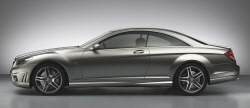Back in the Golden Age of Detroit, owners of imported sports cars viewed the drivers of big block domestic “muscle cars” as unintelligent unsophisticated knuckledraggers. After all, true connoisseurs of the automobile knew that the real joys were in skillfully working the pedals, shifter, and steering, not in being able to deprive one’s frontal lobe of oxygen through the simple act of putting one’s right foot to the floor. Even as recently as a decade ago the smaller, higher-winding engines in imported cars were viewed as a more intelligent approach than Detroit’s reliance on cubic inches. Why did GM need a 3.8-liter V6, when the Japanese did well with 3.0s?
And yet, today, I cannot visit any forum, foreign or domestic, without reading that this car or that one has no low-end torque, and that this is a dealkiller. I’m reading this today over at BimmerForums.com about the Porsche Cayman S, a car whose 3.4-liter flat six musters up “only” 251 foot-pounds of torque at 4,400 rpm.
 Let’s get some perspective. A couple dozen years ago, when I started driving, the Porsche 911 got by with a 3.0-liter flat six good for 175 foot-pounds of torque at 4,200 rpm. Even the mighty V8-powered 928 offered only 265 foot-pounds at 4,000 rpm. In other words, the Cayman S’ engine has about as strong a midrange as Porsche’s 1980s flagship.
Let’s get some perspective. A couple dozen years ago, when I started driving, the Porsche 911 got by with a 3.0-liter flat six good for 175 foot-pounds of torque at 4,200 rpm. Even the mighty V8-powered 928 offered only 265 foot-pounds at 4,000 rpm. In other words, the Cayman S’ engine has about as strong a midrange as Porsche’s 1980s flagship.
Today you can still buy a few truly torque-free sports cars, most notably the Honda S2000 and Mazda RX-8. And I personally have no problem with the 160-or-so pound-feet of torque in these cars. That the Cayman S should become the target for similar criticism is beyond me.
Why don’t I have a problem even with the Honda and Mazda? I suppose because I drive manuals and have no qualms about downshifting to secure the necessary forward motivation. Find a nice curvy country road and keep the speed over 30, and you’ll never have to experience the bottom end in either car.
Perhaps the problem is that these driving conditions are not typical. More often than not, people experience acceleration at traffic lights. So they’re accelerating from a dead stop, and the experience from zero to thirty is key.
Add an automatic transmission into the equation, and the desire for low-end grunt gets kicked up another notch. The involvement provided by the clutch and shifter is absent. With an automatic on your typical straight suburban boulevard, all there is for the driver to do is put his or her foot to the floor. The car does the rest. And so the only thrill to be had is being thrown back into the seat by a wave of torque.
And then there’s the matter of satiation–or lack thereof. With a classic sports car on a curvy road, joy comes from honing one’s skills with the pedals, shifter, and steering on turn after turn. One doesn’t grow tired of a good car in this context. In contrast, the mind builds up a tolerance for torque. Yesterday’s rocket becomes today’s slug. An ever-increasing amount of the stuff is required to maintain the excitement of driving.
And so we find that even as quick a car as the Cayman S still doesn’t have what it takes. And that the typical Asian brand family sedan can be had with a 3.5-liter V6, with even larger engines just over the horizon. After making fun of Detroit’s ridiculously large engines for decades, the imports are now offering engines that are just as large.
Where does it end? It’s already possible to buy a huge Mercedes coupe with a twin-turbocharged 6.0-liter V12 good for 738 foot-pounds of torque at a low, low 2,000 rpm. Sports car? Not even close. Instead, the CL65 is the ultimate muscle car.
Apparently Detroit had the right formula after all.